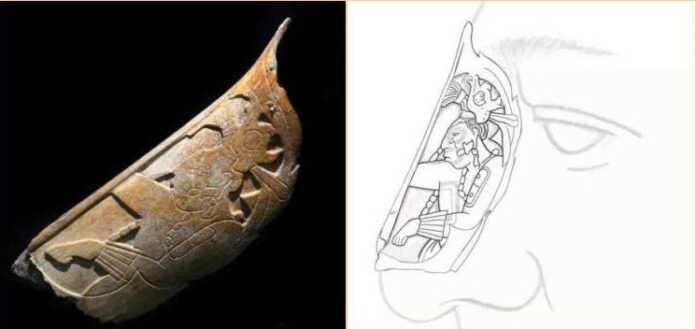A Remarkable Find in the Archaeological Zone of Palenque

Archaeologists from the National Institute of Anthropology and History (INAH) have made a fascinating discovery at House C, part of the palace complex built by Pakal the Great in the Archaeological Zone of Palenque, Chiapas. The team uncovered a nose ornament crafted from a human distal tibia, intricately engraved with a scene depicting communication with gods and ancestors.
Significance of the Nose Ornament
This nose ornament is the first of its kind found in Palenque, representing an attire worn by rulers and priests during ceremonies where they embodied K’awiil, the Mayan god of maize and fertility. The Maya often depicted K’awiil in rituals associated with royal inauguration and the promise of “Innumerable Generations.”

The ornament has been dated to the Late Classic period (600 to 850 A.D.) of Mesoamerican history and was discovered within a ritual deposit in a stucco floor. The excavation revealed a pit filled with clay soil, charcoal remains, animal bones, obsidian blades, and a human bone nose ring, indicating the ceremonial significance of the site.
Detailed Description of the Artifact
According to INAH, the earth matrix surrounding the artifact was dark, rich with charcoal, and intermingled with various remains, including seeds and small mammals. The nose ornament itself is notable for its aesthetic merit, measuring 6.4 centimeters long, 5.2 centimeters wide, and 5 centimeters thick at the base, tapering towards the top.

The exquisite carving features a profile of a man wearing bird-shaped headgear, alongside a representation of a human skull without a lower jaw. The left arm of the ornament shows the Mayan glyph ak’ab’, meaning “darkness” or “night.”

Arnoldo González Cruz, director of the Palenque Archaeological Project, noted that the elongated head shape is characteristic of the divinity K’awiil. This suggests that the ornament was likely worn by rulers and priests during significant ceremonies, further illuminating the cultural practices of the ancient Maya.

